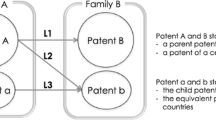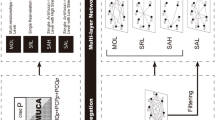Abstract
Because some cited references are not relevant to the citing patent and not all the relevant references are cited, the study attempts to use the bibliographic coupling (BC) approach to filter the irrelevant patent citations and supplement the relevant uncited patent citations to construct a patent citation network (PCN). The study selected the field of electric vehicle technology to explore the phenomenon and examined the characteristics of PCNs in terms of the average BC strength and the average citation time lag. Four PCNs were constructed in this study. The aggregated PCN (APCN) excluded the irrelevant patent citations and added the relevant uncited patent citations, which has brought out significant improvement. The APCN became more concentrated and the information which reserved in the APCN was the most current. Additionally, some invisible technology clusters and relationships were also manifested in the APCN.






Similar content being viewed by others
References
Albert, M., Avery, D., Narin, F., & McAllister, P. (1991). Direct validation of citation counts as indicators of industrially important patents. Research Policy, 20(3), 251–259.
Atallah, G., & Rodriguez, G. (2006). Indirect patent citations. Scientometrics, 67, 437–465.
Bichteler, J., & Parsons, R. G. (1974). Document retrieval by means of an automatic classification algorithm for citations. Information Storage and Retrieval, 10(7–8), 267–278.
Borgatti, S. P., & Cross, R. (2003). A relational view of information seeking and learning in social networks. Management Science, 49(4), 432–445.
Breschi, S. & Lissoni, F. (2005). Knowledge Networks from Patent Data. Handbook of Quantitative Science and Technology Research, pp. 613–643.
Carpenter, M., & Narin, F. (1983). Validation study: patent citations as indicators of science and foreign dependence. World Patent Information, 5(3), 180–185.
Case, D. O., & Higgins, G. M. (2000). How we can investigate citation behaviour ? A study of reasons for citing literature in communication. Journal of the American Society for Information Science, 51, 635–645.
Chen, A., & Chen, R. (2007). Design patent map: an innovative measure for corporative design strategies. Engineering Management Journal-Rolla, 19(3), 14.
Chen, D. Z., Huang, M. H., Hsieh, H. C., & Lin, C. P. (2011). Identifying hidden relevant patent citation links by using bibliographical coupling in LED illuminating technology. Journal of Informetics, 5(3), 400–412.
Ellis, P., Hepburn, G., & Oppenheim, C. (1978). Studies on patent citation networks. Journal of Documentation, 34, 12–20.
Ernst, H. (2003). Patent information for strategic technology management. World Patent Information, 25(3), 233–242.
Fontanaa, R., Nuvolaric, A., & Verspagend, B. (2009). Mapping technological trajectories as patent citation networks: an application to data communication standards. Economics of Innovation and New Technology, 18(4), 311–336.
Griliches, Z. (1990). Patent statistics as economic indicators: a survey. Journal of Economic Literature, 28, 1661–1707.
Hall, B., Jaffe, A., & Trajtenberg, M. (2001). The NBER patent citation data file: lessons. NBER working paper: Insights and Methodological Tools.
Hall, B., Jaffe, A., & Trajtenberg, M. (2005). Market value and patent citations. RAND Journal of Economics, 36(1), 16–38.
Huang, M., Chiang, L., & Chen, D. (2003). Constructing a patent citation map using bibliographic coupling: a study of Taiwan’s high-tech companies. Scientometrics, 58(3), 489–506.
Jaffe, A., & Trajtenberg, M. (1999). International knowledge flows: evidence from patent citations. Economics of Innovation and New Technology, 8(1), 105–136.
Jarneving, B. (2007). Bibliographic coupling and its application to research-front and other core documents. Journal of Informetrics, 1(4), 287–307.
Johnson, S. C. (1967). Hierarchical clustering schemes. Psychometrika, 32(3), 245–254.
Kessler, M. (1963). Bibliographic coupling between scientific papers. American Documentation, 14(1), 10–25.
Lanjouw, J. O., & Schankeman, M. (2004). Patent quality and research productivity: measuring innovation with multiple indicators. Economic Journal, 114(495), 441–465.
Lee, H., Kim, C., Cho, H., & Park, Y. (2009). An ANP-based technology network for identification of core technologies: a case of telecommunication technologies. Expert Systems with Applications, 36(1), 894–908.
Liu, S., & Shyu, J. (1997). Strategic planning for technology development with patent analysis. International Journal of Technology Management, 13(5), 661–680.
Lo, S. C. S. (2010). A comparative study of linkage indexes: co-assignee, reciprocal citation, patent coupling and co-patent. Journal of Library and Information Studies, 8(1), 11–27.
Meng, H. C., Hwang, M. J., Chang, D. M., & Kuo, K. H. (2000). Industry innovation indicator: patent citation analysis and patent indicator (I). Journal of Technology Management, 5(1), 31–49. (In Chinese).
Meyer, M. (2000). What is special about patent citaions? Differences between scientific and patent citations. Scientometrics, 51, 185–201.
Michel, J., & Bettels, B. (2001). Patent citation analysis: a closer look at the basic input data from patent search reports. Scientometrics, 51(1), 185–201.
Nagaoka, S. (2004). Assessing the R&D management of firms by patent citation: evidence from the US Patents. In Proceedings of Nihon Keizai Gakkai Autumn research presentations.
Narin, F. (1994). Patent bibliometrics. Scientometrics, 30(1), 147–155.
Smith, L. (1981). Citation analysis. Library Trends, 30(1), 83–106.
Swanson, D. (1971). Some unexplained aspects of the cranfield tests of indexing performance factors. The Library Quarterly, 41(3), 223–228.
Trajtenberg, M., Henderson, R., & Jaffe, A. (1997). University versus corporate patents: a window on the basicness of invention. Economics of Innovation and New Technology, 5(1), 19–50.
Verspagen, B. (2000). The role of large multinationals in the Dutch technology infrastructure: a patent citation analysis. Scientometrics, 47(2), 427–448.
Wartburg, I. V., Teichert, T., & Rost, K. (2005). Inventive progress measured by multi-stage patent citation analysis. Research Policy, 34(10), 1591–1607.
Yoon, B., & Park, Y. (2004). A text-mining-based Patent network: analytical tool for high-technology trend. The Journal of High Technology Management Research, 15(1), 37–50.
Author information
Authors and Affiliations
Corresponding author
Rights and permissions
About this article
Cite this article
Yeh, HY., Sung, YS., Yang, HW. et al. The bibliographic coupling approach to filter the cited and uncited patent citations: a case of electric vehicle technology. Scientometrics 94, 75–93 (2013). https://doi.org/10.1007/s11192-012-0820-8
Received:
Published:
Issue Date:
DOI: https://doi.org/10.1007/s11192-012-0820-8




